

Rapier. Khopesh. Khopesh (ḫpš; also vocalized khepesh) is an Egyptian sickle-sword that evolved from battle axes.[1] A typical khopesh is 50–60 cm (20–24 inches) in length, though smaller examples do also exist.
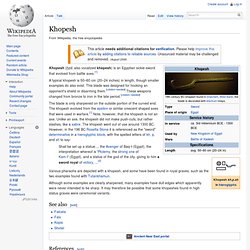
This blade was designed for hooking an opponent's shield or disarming them. [citation needed] These weapons changed from bronze to iron in the late period. [citation needed] Various pharaohs are depicted with a khopesh, and some have been found in royal graves, such as the two examples found with Tutankhamun. Although some examples are clearly sharpened, many examples have dull edges which apparently were never intended to be sharp. Shamshir. A Shamshir (from Persian شمشیر shamshir) also Shamsheer and Chimchir,[1] is a type of sabre with a curve that is considered radical for a sword: 5 to 15 degrees from tip to tip.
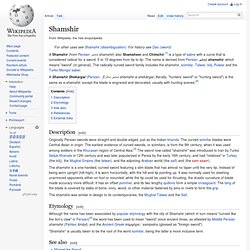
The name is derived from Persian شمشیر shamshīr, which means "sword" (in general). The radically curved sword family includes the shamshir, scimitar, Talwar, kilij, Pulwar and the Turko-Mongol saber. Spada da lato. Replica of a Spada da Lato The spada da lato or "side-sword" is the Italian term for the type of sword popular during the late 16th century, corresponding to the Spanish espada ropera.

It is a continuation of the medieval arming sword and in turn the predecessor of the rapier of the Early Modern period. Its use was taught in the Dardi school of Italian fencing, influential on 17th century rapier fencing. They were ideal for handling the mix of armored and unarmored opponents of that time. Parang (knife) The Parang is a Malaysian and Moluccan big knife, similar to a machete.

Typical vegetation in South East Asia is more woody than in South America and the Parang is therefore optimized for a stronger chopping action with a heavier blade and a "sweet spot" further forward of the handle; the blade is also beveled more obtusely to prevent it from binding in the cut. This is the same rationale and (in practical terms) the same design as the Indonesian Golok and very similar to the Filipino Bolo. A Parang blade is usually 10–24 inches (25–61 cm) long; a blade that is 10 inches and shorter is called Pisau (knife) and a blade that 24 inches and longer is called Pedang (sword). Parang has a mass up to 2 lb and the edge of Parang usually uses a convex grind. Karambit. The karambit or kerambit (Minangkabau language: Kurambiak or Karambiak) is a small Southeast Asian hand-held, curved knife originating in Indonesia.
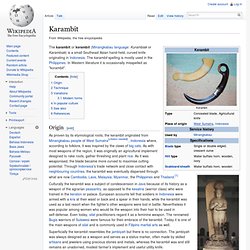
The karambit spelling is mostly used in the Philippines. In Western literature it is occasionally misspelled as "korambit". Origin[edit] As proven by its etymological roots, the kerambit originated from Minangkabau people of West Sumatra[citation needed] , Indonesia where, according to folklore, it was inspired by the claws of big cats. As with most weapons of the region, it was originally an agricultural implement designed to rake roots, gather threshing and plant rice. Longsword. A longsword (also spelled long sword, long-sword) is a type of European sword characterized as having a cruciform hilt with a grip for two-handed use and a straight double-edged blade of around 90 to 110 cm (35 to 43 in),[1] current during the late medieval and Renaissance periods (approximately 1350 to 1550), with early and late use reaching into the 13th and 17th centuries.
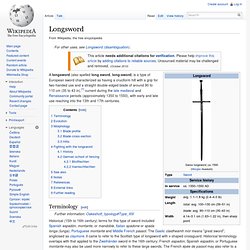
Terminology[edit] Historical (15th to 16th century) terms for this type of sword included Spanish espadón, montante, or mandoble, Italian spadone or spada longa (lunga), Portuguese montante and Middle French passot. The Gaelic claidheamh mòr means "great sword"; anglicised as claymore, it came to refer to the Scottish type of longsword with v-shaped crossguard. Historical terminology overlaps with that applied to the Zweihänder sword in the 16th century: French espadon, Spanish espadón, or Portuguese montante may also be used more narrowly to refer to these large swords.
Yatagan. Katar (dagger) The katar or katara[1][2][3] (Sanskrit: कट्टार kaţāra or kaţārī, Hindi: कटार kaṭāra or kaṭāri, Panjabi: kaṭǎrǎ, Marathi: katyāra, Malayalam: കട്ടാരം katāram, Tamil: கட்டாரி kaţţāri or குத்துவாள் kuttuvāḷ) is a type of push dagger from South Asia.[4] The weapon is characterised by its H-shaped horizontal hand grip which results in the blade sitting above the user's knuckles.

Unique to South Asia, it is the most famous and characteristic of Indian daggers.[5] Ceremonial katar were also used in worship.[6] From the 16th century onwards, katar were often made from broken sword-blades. Even old imported European blades were used, especially by the Maratha Empire, and were riveted to projections from the hilt. After India was colonised by the British, numerous katar were made for the European collectors' market which placed little value on functionality. In another modern katar design, single-shot pistols are built into either side of the weapon. Jump up ^ Dick Luijendijk (2008). Straight razor. A straight razor with square point and a double transverse stabiliser A straight razor closed A straight razor is an old-fashioned razor with a blade that can fold up into its handle.[1][2] They are also called open razors and cut-throat razors.[3][4][5] Although straight razors were once the principal method of manual shaving, they have been largely overshadowed by the safety razor, which incorporates a disposable blade.

Electric razors of various types have also been an available alternative, especially since the 1950s.[5][6][7] Despite this, straight razors still hold a market share, and forums and outlets provide products, directions, and advice to straight razor users. Straight razor manufacturers still exist in Europe, Asia (especially Japan), and North America. Straight razors require considerable skill to hone and strop, and require more care during shaving.[8] These methods were once a major portion of the curriculum in barber colleges.
History[edit] Parts description[edit] Forging. Butterfly knife. A butterfly knife in open and closed position. The balisong was commonly used by Filipino people, especially those in the Tagalog region, as a self-defense and pocket utility knife. A stereotype used to exist that every Batangueño carried one everywhere he or she went.[1] Hollow ground balisongs were also used as straight razors before conventional razors were available in the Philippines. In the hands of a trained user, the knife blade can be brought to bear quickly using one hand. Manipulations, called "flipping" or "fanning", are performed for art or amusement. The knife is now illegal or restricted in many countries, often under the same laws and for the same reasons that switchblades are restricted, and in their country of origin they are no longer as common in urban areas as they were.
Etymology[edit] Balisong is also the name of a barangay in the town of Taal, Batangas province, which became famous for crafting these knives. Hunting dagger. Hunting dagger The hunting dagger (German: Hirschfänger, or deer catcher) is a 20–30-inch (510–760 mm) long double-edged German stabbing hunting knife, used to kill deer and boar.[1] It was a weapon mainly used in the fancy hunts of the German nobility.
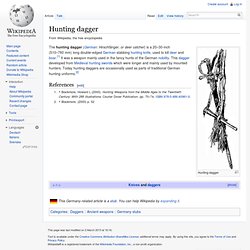
This dagger developed from Medieval hunting swords which were longer and mainly used by mounted hunters. Today hunting daggers are occasionally used as parts of traditional German hunting uniforms.[2] Jump up ^ Blackmore, Howard L (2000). Parrying dagger. An example of unsuccessful main-gauche use A parrying dagger demonstrated in a modern bout.

Hunting knife. An assortment of hunting knives A hunting knife is a knife used during hunting for preparing the game to be used as food: skinning the animal and cutting up the meat. It is different from the Hunting dagger which was traditionally used to kill wild game.[1] Some hunting knives are adapted for other uses in the wild; such as a Camp knife, which hunters may use as machetes or hatchets when those specific tools are not available. In this case, their function is similar to a survival knife. Misericorde (weapon) Misericorde A misericorde was a long, narrow knife, used in medieval times to deliver the death stroke (the mercy stroke, hence the name of the blade, derived from the Latin misericordia, "act of mercy") to a seriously wounded knight.
The blade was thin enough so that it could strike through the gaps between armour plates.[1] This weapon was used to dispatch knights who had received mortal wounds, which were not always quickly fatal in the age of bladed combat; it could also be used as a means of killing an active adversary, as during a grappling struggle.[1] The blade could be pushed through the visor or eye holes in the helm with the aim of piercing the brain, or thrust through holes or weak points in plate armor, such as under the arm, with the aim of piercing the heart.
The weapon was known from the 12th century and has appeared in the armaments of Germany, Persia, and England.[2][3] Janbiya. Janbiya, also spelled janbia, jambiya, and jambia (Arabic: جنبية janbīyah), is the Arabic term for dagger, but it is generally used to describe a specific type of dagger with a short curved blade that is worn on a belt. Dirk. Japanese WW2 naval dirk. Tantō. Backsword. Sabre.